Asparagus densiflorus ‘Cwebe’
Asparagus densiflorus (Kunth) Jessop ‘Cwebe’
Family: Asparagaceae
Common names: Cwebe asparagus fern, Cwebe emerald fern, Cwebe basket asparagus (Eng.); smaragsiervaring (Afr.); isiqobola, umgcagcazane, uvelabahleke (Zul.)
Introduction
A handsome ornamental perennial whose graceful spreading fronds has broader needle-like leaflets than the other varieties of asparagus fern. New foliage is a shiny, rich copper-bronze colour, which highlights this plant’s exceptional beauty of form.
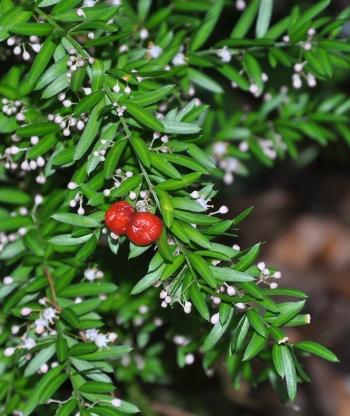
Description
Description
Asparagus densiflorus ‘Cwebe’ is a beautiful garden plant, up to approximately 300–500 mm high, with arching, spreading branches, up to 800 mm long and approximately 300–600 mm wide. The plants have a rhizomatous root system with long fibrous roots bearing oval, turgid, creamy-beige tubers all along the side roots, which assist the plant in surviving long periods of drought. The long evergreen stems of this plant emerge directly from the ground, becoming slightly woody at their bases as they mature, are densely covered in bright green, flattened, long needle-like leaflets that create an attractive delicately textured appearance.

What appear to be the bright green ‘leaflets’ are actually small modified stems called cladophylls. The real leaves are heavily-reduced, bract-like spurs which, when mature, harden to form the characteristic spines found in most species of Asparagus. Most of the South African Asparagus species have dreadfully sharp spines, and some of them quite large. A. densiflorus has only very small, hardly noticeable spines and is, therefore, a much friendlier garden plant. The small, linear, flattened cladophylls occur in groups of 3 or more at each node and give the plants foliage its characteristic shape and form.
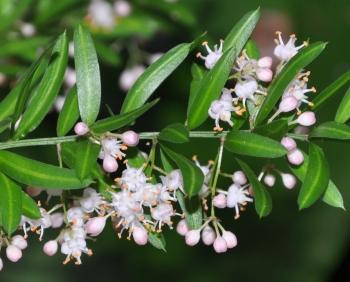
Tiny, sweetly fragrant white flowers are borne close along the stems, nestled in the branch axils, and occur erratically from November to April.
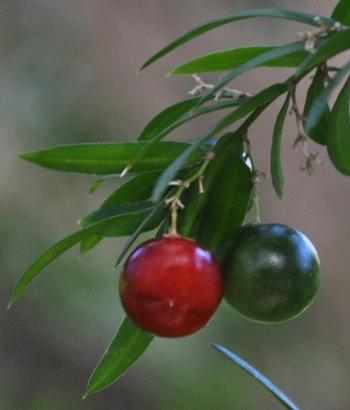
Rounded green berries appear from March; often while the plant is still flowering, ripening to showy bright red; each fruit has 1 large black seed in them.
Conservation Status
Status
Asparagus densiflorus is not threatened, and is listed with the conservation status of Least Concern (LC).
Distribution and habitat
Distribution description
This cultivar was found growing in the lowland forest of the Cwebe Nature Reserve, which is bordered by the Mbashe River, the Indian Ocean and the rugged grasslands of the Eastern Cape.
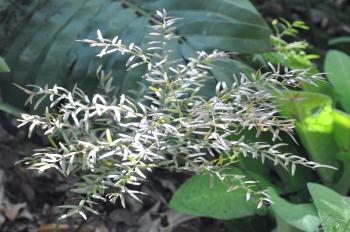
Derivation of name and historical aspects
History
The genus Asparagus derives its name from the Greek word Asparagos, the name given to the cultivated edible asparagus (Asparagus officinalis) and is possibly derived from a meaning ‘intensive’ and sparassa, meaning ‘to tear’, referring to the sharp spines of many species, or possibly from spargan, meaning ‘to swell’ or ‘sprout’, referring to the plants root tubers that are swollen and fibrous roots from which they can resprout.
The species name densiflorus, refers to the way the small flowers are borne tightly along the stem of the plant.
The cultivar name ‘Cwebe’ refers to this form’s original wild natural locality.
Commonly known as the asparagus fern, or emerald fern, although it is not actually a fern at all. These common names have originated from the foliage resembling a fern leaf, and from the plants growing in the same environments and habitats as ferns.
Asparagus is the largest genus within the family Asparagaceae and consists of approximately 200 species, which are distributed throughout Africa, Asia, and Europe; introduced in Australia. Currently in southern Africa there are 86 recognized species of Asparagus, which can be herbaceous perennials, woody shrubs or climbers. They are widespread and common, but are not often collected because of the short flowering period and the presence of spines that can cause the experience of handing the plants to be very painful. Asparagus densiflorus has many lovely cultivars, the most noteworthy of which are A. densiflorus ‘Meyersii’, A. densiflorus ‘Flagstaff’ and A. densiflorus ‘Mazeppa’.
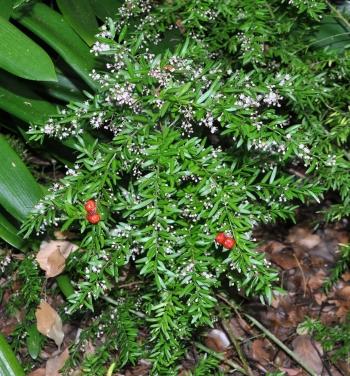
Ecology
Ecology
All species of Asparagus have the identifying characteristic of the modified photosynthetic stems called cladodes (instead of true leaves), and many species have large, sharp spines that cause pain to humans and animals. Asparagus densiflorus cultivars have only very small, insignificant short spines making them all excellent garden subjects, although these spines can cause significant irritation to people’s skin when handling the plant.
When in flower, the sweetly scented flowers attract pollinating insects which in turn attract insectivorous birds and reptiles. The berries are eaten by a wide variety of fruit-loving birds, which then assist in the distribution of the seeds.
The fibrous roots and their swollen tubers store water and nutrients, and allow the plant to survive periods of drought and also enable them to resprout if the stems are damaged in any way.
A. densiflorus is a declared invasive weed in Australia and has the potential to become invasive in other countries in areas with a similar microclimate to where it occurs naturally in South Africa.
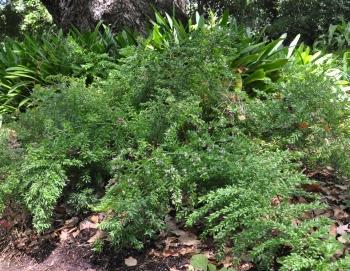
Uses
Use
Asparagus species are popular garden and ornamental landscaping plants, because they are hardy and waterwise, but also for their structural use with their outstanding textural and emerald green foliage.
Asparagus stems are extremely popular in floristry, used predominantly as filler foliage, with A. plumosus being the most widely used.
Asparagus densiflorus is related to the edible asparagus, A. officinalis, and some of the South African Asparagus species roots are eaten by local peoples traditionally as vegetables, and many are used for medicinal purposes. The berries can cause low toxicity if eaten by humans and other mammals, or if crushed, they cause a minor skin irritation that luckily does not last for very long.
Growing Asparagus densiflorus ‘Cwebe’
Grow
An extremely versatile and hardy evergreen perennial with its decorative, finely textured foliage, coppery new growth, pretty white flowers and bright berries makes it an rewarding plant for any gardener, as it is an especially easy plant for beginner gardeners to use and enjoy, as it is so very easy to grow and does not require any special care. This asparagus fern grows in any soil and will tolerate some drought and periods of neglect once established, but it does look its best in well-drained soil which is rich in organic matter. Asparagus densiflorus is adapted to a variety of conditions, growing in bright light or semi-shade, but out of direct sun. This cultivar looks best when grown in full/dappled/light or semi-shade. Generally the plants require no more fertilizing than a biannual application of well-rotted compost.
Asparagus densiflorus ‘Cwebe’ does well outdoors in the garden massed as a groundcover, or as filler plants. The fine foliage can be used to good visual effect for textural contrast in combination with plants having larger leaves and is also very suitable to being used to complement water features, such as ponds. Water only moderately as the plant’s thick, tuberous roots store water. As a waterwise, shade-loving plant, they are well suited for growing in the dry shade conditions found under trees, where few plants thrive. It combines well with other shade-loving plants, such as species of Streptocarpus, Chlorophytum, Plectranthus , Scadoxus, Clivia and Hypoestes. Can also be used as house plants indoors and on covered patios, being hardy they do well in containers/pots, in hanging baskets, even in retaining walls. The foliage can also be incorporated as filler material between cut flowers in floral arrangements.
This plant is low maintenance as it only requires dead fronds or the occasional old, yellowed stem to be cut away. To rejuvenate the plants, they can be cut back hard, right at the base, after flowering in May or in early spring, in September, before new growth begins. The same can be done if fronds are damaged/broken or ‘burnt’ by frost. Afterwards a mulch of thick compost can be spread around the plant’s base to provide the food support needed for replenishing lost top growth. The plants will produce new healthier, greener foliage after pruning. The plants are generally and naturally pest and disease free.
Asparagus densiflorus ‘Cwebe’ is easily propagated from seed. Cuttings are not a viable method of propagation. Collect fully ripened fruit then remove the seeds from the fleshy berries; there is no pre-treatment of the seeds required. Sow seed fresh for best results in a suitable sowing medium, keep in a warm spot in an area that is protected from the wind, in light shade; ensure the soil stays moist but not wet, by watering as required. The seeds will germinate in 4 to 6 weeks; the growth from seeds is slow but steady. Fertilize with a liquid fertilizer at regular intervals to ensure flourishing and plentiful growth during the growing on stage. Prick out seedlings when well grown, and repot into a compost-rich, loamy medium. Grow on in light shade, and water regularly until roots are visible growing out the growing container’s drainage holes. Plants can then be planted out into a larger pot, or directly into the garden.
Division by separating the tubers into clumps just as growth starts in spring, is also an option, but most often is a less successful way of increasing this particular cultivar.
References
- Goldblatt, P. & Manning, J. 2000. Cape Plants. A conspectus of the Cape flora of South Africa. Strelitzia 9. National Botanical Institute, Pretoria & Missouri Botanical Garden, Missouri.
- Joffe, P. 2001. Creative gardening with indigenous plants. Briza Publications, Pretoria.
- Leistner, O.A. (ed.). 2000. Seed plants of southern Africa: families and genera. Strelitzia 10. National Botanical Institute, Pretoria.
- Leistner, O.A. (ed.). 2005. Seed plants of southern tropical Africa: families and genera. Southern African Botanical Diversity Network Report No. 26. SABONET, Pretoria
- Pienaar, K. 1984. The South African what flower is that? Struik, Cape Town.
- Pooley, E. 1998. A field guide to wild flowers Kwazulu-Natal and the eastern region. Natal Flora Publications Trust, Durban.
- Powrie, F. 1998. Grow South African Plants. A gardener's companion to indigenous plants. National Botanical Institute, Cape Town.
Credits
Cherise Viljoen
Kirstenbosch Botanical Garden
July 2018
Plant Attributes:
Plant Type: Ground Cover, Perennial
SA Distribution: Eastern Cape, KwaZulu-Natal
Soil type: Sandy, Clay, Loam
Flowering season: Early Summer, Late Summer, Autumn
PH: Acid, Alkaline, Neutral
Flower colour: White
Aspect: Shade, Morning Sun (Semi Shade), Afternoon Sun (Semi Shade)
Gardening skill: Easy
Special Features:
Horticultural zones











Rate this article
Article well written and informative
Rate this plant
Is this an interesting plant?
Login to add your Comment
Back to topNot registered yet? Click here to register.